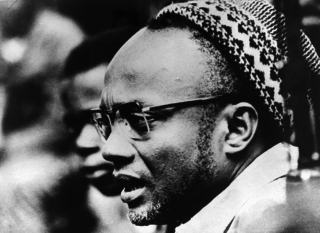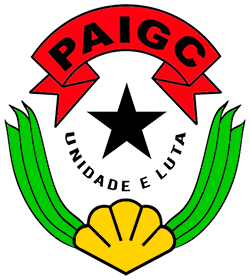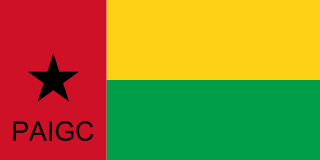The Military ranks of Guinea-Bissau are the military insignia used by the Military of Guinea-Bissau.
The Military ranks of Guinea-Bissau are the military insignia used by the Military of Guinea-Bissau.
The rank insignia of commissioned officers.
| Rank group | General / flag officers | Senior officers | Junior officers | Officer cadet | ||||||||||||||||||||||||||||||||
|---|---|---|---|---|---|---|---|---|---|---|---|---|---|---|---|---|---|---|---|---|---|---|---|---|---|---|---|---|---|---|---|---|---|---|---|---|
 |  |  |  |  |  |  |  |  | |  | ||||||||||||||||||||||||||
| General | Tenente-general | Major-general | Brigadeir-general | Coronel | Tenente-coronel | Major | Capitão | Primeiro tenente | Tenente | Subtenente | ||||||||||||||||||||||||||
| | | | | | | | | |||||||||||||||||||||||||||||
| Capitão de mar e guerra | Capitão de fragata | Capitão-tenente | Primeiro-tenente | Segundo-tenente | Guarda-marinha Subtenente | |||||||||||||||||||||||||||||||
| Rank group | General / flag officers | Senior officers | Junior officers | Officer cadet | ||||||||||||||||||||||||||||||||
The rank insignia of non-commissioned officers and enlisted personnel.
| Rank group | Senior NCOs | Junior NCOs | Enlisted | |||||||||||||||||||||||||||||||||
|---|---|---|---|---|---|---|---|---|---|---|---|---|---|---|---|---|---|---|---|---|---|---|---|---|---|---|---|---|---|---|---|---|---|---|---|---|
 |  |  |  |  | ||||||||||||||||||||||||||||||||
| Primeiro-sargento | Segundo-sargento | Terceiro-sargento | Primeiro-Soldado | Soldado | ||||||||||||||||||||||||||||||||
| Rank group | Senior NCOs | Junior NCOs | Enlisted | |||||||||||||||||||||||||||||||||
The rank insignia for commissioned personnel for the former military branch of the African Party for the Independence of Guinea and Cape Verde.
| Rank group | General / flag officers | Senior officers | Junior officers | Officer cadet | ||||||||||||||||||||||||||||||||
|---|---|---|---|---|---|---|---|---|---|---|---|---|---|---|---|---|---|---|---|---|---|---|---|---|---|---|---|---|---|---|---|---|---|---|---|---|
| | | | | | | | | |||||||||||||||||||||||||||||
| Comandante de brigada | Primeiro comandante | Comandante | Major | Capitão | Primeiro tenente | Tenente | Subtenente | |||||||||||||||||||||||||||||
The rank insignia for enlisted personnel for the former military branch of the African Party for the Independence of Guinea and Cape Verde.
| Rank group | Senior NCOs | Junior NCOs | Enlisted | |||||||||||||||||||||||||||||||||
|---|---|---|---|---|---|---|---|---|---|---|---|---|---|---|---|---|---|---|---|---|---|---|---|---|---|---|---|---|---|---|---|---|---|---|---|---|
The Cape Verdean Armed Forces, Cabo Verdean Armed Forces or FACV are the military of Cape Verde. They include two branches, the National Guard and the Coast Guard.

The recorded history of Cape Verde begins with the Portuguese discovery of the island in 1458. Possible early references to Cape Verde date back at least 2,000 years.
"Esta É a Nossa Pátria Bem Amada" is the national anthem of Guinea-Bissau. Written in 1963 by Amílcar Cabral (1924–1973) and composed by Xiao He (1918–2010), it was adopted upon independence from Portugal in 1974.

Aristides Maria Pereira was a Cape Verdean politician. He was the first President of Cape Verde, serving from 1975 to 1991.

Luís Severino de Almeida Cabral was a Bissau-Guinean politician who was the first President of Guinea-Bissau. He served from 1974 to 1980, when a military coup d'état led by João Bernardo Vieira deposed him. Luís Cabral was a half-brother of Amílcar Cabral, with whom he co-founded the African Party for the Independence of Guinea and Cape Verde (PAIGC) in 1956.

The national flag of Guinea-Bissau was adopted in 1973 when independence from Portugal was proclaimed.

Amílcar Lopes da Costa Cabral was a Bissau-Guinean and Cape Verdean agricultural engineer, political organizer, and diplomat. He was one of Africa's foremost anti-colonial leaders. He was also a pan-Africanist and intellectual nationalist revolutionary poet.

The African Party for the Independence of Guinea and Cape Verde is a political party in Guinea-Bissau. Originally formed to peacefully campaign for independence from Portugal, the party turned to armed conflict in the 1960s and was one of the belligerents in the Guinea-Bissau War of Independence. Towards the end of the war, the party established a socialist one-party state, which remained intact until multi-party democracy was introduced in the early 1990s. Although the party won the first multi-party elections in 1994, it was removed from power in the 1999–2000 elections. However, it returned to office after winning parliamentary elections in 2004 and presidential elections in 2005, since which it has remained the largest party in the National People's Assembly.

The African Party of Independence of Cape Verde is a democratic socialist political party in Cape Verde. It was formerly a Marxist–Leninist communist party and the sole legal party in the country from 1981 to 1990. Its members are nicknamed "os tambarinas" in Portuguese, and they identify themselves with the color yellow.

The Guinea-Bissau War of Independence, or the Bissau-Guinean War of Independence, was an armed independence conflict that took place in Portuguese Guinea from 1963 to 1974. It was fought between Portugal and the African Party for the Independence of Guinea and Cape Verde, an armed independence movement backed by Cuba, the Soviet Union, and Yugoslavia. The war is commonly referred to as "Portugal's Vietnam" because it was a protracted guerrilla war which had extremely high costs in men and materiel and which created significant internal political turmoil in Portugal.

The Revolutionary Armed Forces of the People or FARP were originally the armed wing of the African Party for the Independence of Guinea and Cape Verde during the struggle against Portuguese rule in Guinea-Bissau and Cape Verde. Since 1973, they constitute the national armed forces of Guinea-Bissau. A separate Cape Verdean branch of the FARP constituted the national armed forces of this country from 1975 until the early 1990s, when these were renamed "Cape Verdean Armed Forces".
The Indonesian National Armed Forces (TNI) uses a simplified ranking system for the three branches of Indonesian Army, Indonesian Navy and Indonesian Air Force. Most of the ranks are similar with differences for the rank titles of the high-ranking officers. Exception exists, however, in the ranks of the service members of the Indonesian Marine Corps. While Indonesian Marine Corps is a branch of the Navy, the rank titles of the Marine Corps are the same as those of the Army, but it still uses the Navy's style insignia.
The Military ranks of Romania are the military insignia used by the Romanian Armed Forces.

Cape Verde–Guinea Bissau relations refers to the bilateral relationship between the Republic of Cape Verde and the Republic of Guinea-Bissau. Cape Verde is an island country about 900 km north-west of Guinea-Bissau, a coastal West African country. Both were colonies of the Portuguese Empire and they campaigned together for independence with a plan for unification, but the countries separated after 1980. The two countries were both founder members of the Community of Portuguese Language Countries (CPLP) in 1996, and are each members of the African Union and the Economic Community of West African States (ECOWAS).
The Military ranks of Equatorial Guinea are the military insignia used by the Armed Forces of Equatorial Guinea. Being a former colony of Spain, Equatorial Guinea shares a rank structure similar to that of Spain.
The Military ranks of Guinea are the military insignia used by the Republic of Guinea Armed Forces. Being a former colony of France, Guinea shares a rank structure similar to that of France.

The 1980 Guinea-Bissau coup d'état was the bloodless military coup that took place in Guinea-Bissau on 14 November 1980, led by Prime Minister General João Bernardo Vieira. It led to the deposition of President Luís Cabral, who held the office since 1973, while the country's War of Independence was still ongoing.

Military ranks of Cape Verde are the insignia used to denote rank in the Cape Verdean Armed Forces, including the National Guard and Coast Guard.